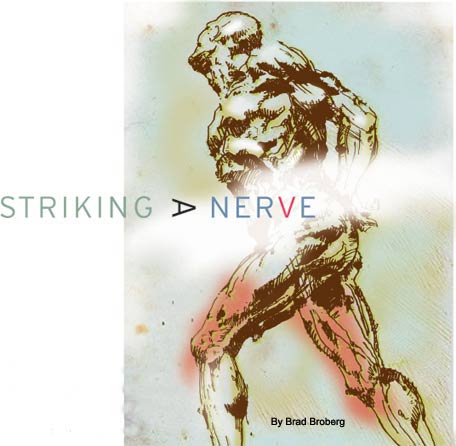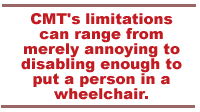

While it's still unknown whether slow conduction causes CMT or merely indicates it, the Mayo Clinic's findings fed a new view of the disease. "What was developing was the realization that it wasn't just one disease," says Bird. "The long-term question was could we find the genes that caused the disease."
It was through sheer happenstance that a nerve conduction test-similar to the ones done at the Mayo Clinic-alerted Street she had CMT. As an undergraduate at Whitman College in 1985, she was participating in an internship with a local neurologist when he demonstrated how to perform the test using Street as his patient. The results showed dramatic slowing. The doctor suspected CMT.
"I had never heard of it," says Street. "I said, 'OK, whatever.' I wasn't having any problems. I was doing triathlons and running marathons. I didn't even give it a second thought."
It wasn't long before Street's feet began to ache when she ran. By that time, she was in graduate school at the UW School of Pharmacy. Aware of Bird's CMT expertise, she sought him out for a definitive diagnosis.
Historically, doctors have relied on observation, certain physical tests and family history. However, lack of awareness of the disease and the varying degree of its symptoms often lead to misdiagnosis. "It goes unrecognized by a lot of doctors," says Bird.
As more and more of the genes associated with various forms of CMT are found, DNA testing is leaving fewer and fewer patients in the dark about what ails them. Helping lay the foundation for such testing was Bird's landmark 1980 study. After finding telltale genetic markers in DNA samples from members of a CMT-1 family, Bird determined that the gene responsible for their form of the disease must reside somewhere among the thousands of genes located on chromosome 1-one of 23 pairs of DNA molecules found in every cell.
In the years that followed, scientists took Bird's work to the next level by precisely locating some of the specific genes associated with various forms of CMT. As a result, doctors like Bird could give more CMT patients a solid diagnosis. Based on DNA from a blood sample, Street was definitively diagnosed with it in 1992.

Five years later, as a postdoctoral fellow at the UW, Street sought Bird out again, not as a patient, but as a scientist interested in studying the disease that was giving her so much pain. At the time, Bird and Chance were looking for a genetic link within a group of CMT-1 families. The two senior scientists invited Street to take a crack at finding the elusive gene.
In a study like Street's, the goal is to find an abnormal version of a normal gene unique to everyone who has the disease. The question is where to start looking. Typically scientists begin by making a few educated guesses. Their sign posts? Patches of DNA known as genetic markers.
Genetic markers occur at the same locations in everyone's DNA, usually between genes but sometimes within them. Like genes, markers consist of sets of chemical units called base pairs. However, unlike genes, every marker features the same two base pairs repeated over and over again.
While genes produce proteins, which drive the biological machinery of the body, markers perform no known functions-hence their frequent description as "junk" DNA. Even so, genetic markers are far from useless. Although they appear in the same locations in everyone's DNA, their lengths are often unique, which is how DNA evidence can be used to establish an individual's identity.
For gene-hunters like Street, markers establish boundaries. If the lengths of a certain group of markers within family members affected by a disease are similar to each other but different from those in healthy family members, odds are there's trouble, genetically speaking, in the neighborhood.
Street used powerful computerized DNA analyzers to locate a group of telltale markers in her study families. From there, it was only a matter of time before she arrived at the doorstep of the misbehaving gene, which she called SIMPLE.
"It was very exciting-it was the first human disease I had worked on," recalls Street. "While exciting, there are lots of verification steps involved that require days and weeks of work. So it takes awhile to make sure you have the correct answer."
In the short run, Street's discovery provides one more group of CMT patients a way to gain a definitive diagnosis so doctors will "stop treating them for other things," says Street. In the long run, it provides scientists with another rung in the ladder they're climbing toward a cure. Right now, Chance is studying the SIMPLE protein to learn what it normally does compared to what the flawed version does-or doesn't do-and how that might cause CMT. The answer may bring medical science one step closer to developing a way to intervene and prevent the disease.
"You hope by studying these diseases, you can develop therapies for people who have it, but it won't happen overnight," says Street.
In the meantime, MacCulloch continues to cope "sometimes well, sometimes not so well" with the enigmatic ailment. "It's challenged my faith," he says. "It's been good to dig down deep to see what life really means."
Go To: Page 1 | Page 2
Sidebar - Haunted for Five Generations